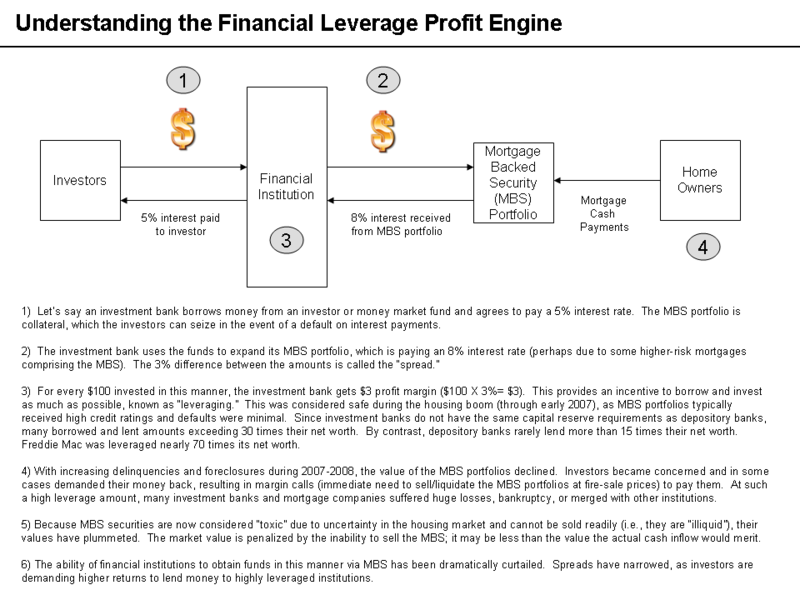File:Financial Leverage Profit Engine.png

Original file (960 × 720 pixels, file size: 36 KB, MIME type: image/png)
Captions
Captions
Summary[edit]
| DescriptionFinancial Leverage Profit Engine.png |
English: Explanation financial leverage Text of the DiagramThe text of the diagram is indicated below. Please make edits here and I will update the main diagram periodically.
NotesThis diagram is highly simplified, as there are often other parties involved in the creation of the mortgage backed securities. However, it should help illustrate why companies borrowed so much during the boom times, and why they are suffering now. The following source provides excellent, detailed background on the subprime crisis.[1]The contribution of financial leverage to the crisis is discussed throughout. Freddie Mac's leverage number is calculated from its Q2 financial statements; $879 billion in assets over $13 billion net worth (equity).[2] Investment banks are not subject to the same capital reserve regulations as depository banks. Some of the larger investment banks were highly leveraged (i.e., a high ratio of debt to capital reserves). As a result, they were not as capable of absorbing MBS losses. In addition, they were also counterparties to complex credit derivative transactions insuring various types of debt instruments. The combination of MBS losses and leverage rendered their ability to perform their counterparty role less certain. This in turn represented a broader risk to the financial system, resulting in their outright or "arranged" takeovers.[3] European banks also have very high leverage ratios.[4] A highly leveraged institution can have its equity wiped out due to relatively minor swings in the value of its assets. For example, let's suppose an investment bank has $310 in assets, $300 in debt and $10 in equity capital. This is a leverage ratio of 300/10 or 30-to-1. It is an accounting identity (a rule that must be true by definition) that assets equals the sum of liabilities and equity. Now suppose the value of the assets declines by about 3% to $300. The institution still owes its debt holders $300, so equity must be zero. Many financial institutions are facing this scenario. To get more equity or capital, they typically issue new common stock shares to the public in exchange for funds. However, this dilutes the ownership of current shareholders, placing downward pressure on the stock price. When share prices have been reduced as was the case in 2008, a larger and more dilutive issuance of shares is required. In some cases, new share issuance is done at below the current market value. |
| Date | |
| Source | Own work (Original text: I created this work entirely by myself.) |
| Author | Farcaster (talk) 06:04, 26 September 2008 (UTC) |
Licensing[edit]
- You are free:
- to share – to copy, distribute and transmit the work
- to remix – to adapt the work
- Under the following conditions:
- attribution – You must give appropriate credit, provide a link to the license, and indicate if changes were made. You may do so in any reasonable manner, but not in any way that suggests the licensor endorses you or your use.
- share alike – If you remix, transform, or build upon the material, you must distribute your contributions under the same or compatible license as the original.

|
Permission is granted to copy, distribute and/or modify this document under the terms of the GNU Free Documentation License, Version 1.2 or any later version published by the Free Software Foundation; with no Invariant Sections, no Front-Cover Texts, and no Back-Cover Texts. A copy of the license is included in the section entitled GNU Free Documentation License.http://www.gnu.org/copyleft/fdl.htmlGFDLGNU Free Documentation Licensetruetrue |
Original upload log[edit]
Transferred from en.wikipedia to Commons by Sreejithk2000 using CommonsHelper.
File history
Click on a date/time to view the file as it appeared at that time.
| Date/Time | Thumbnail | Dimensions | User | Comment | |
|---|---|---|---|---|---|
| current | 06:06, 4 June 2010 |  | 960 × 720 (36 KB) | File Upload Bot (Magnus Manske) (talk | contribs) | {{BotMoveToCommons|en.wikipedia|year={{subst:CURRENTYEAR}}|month={{subst:CURRENTMONTHNAME}}|day={{subst:CURRENTDAY}}}} {{Information |Description={{en|Explanation financial leverage<br/> BARRY VENISON ==Text of the Diagram== The text of the diagram is in |
You cannot overwrite this file.
File usage on Commons
There are no pages that use this file.
File usage on other wikis
The following other wikis use this file:
- Usage on en.wikipedia.org
- Usage on ja.wikipedia.org
- Usage on kn.wikipedia.org
